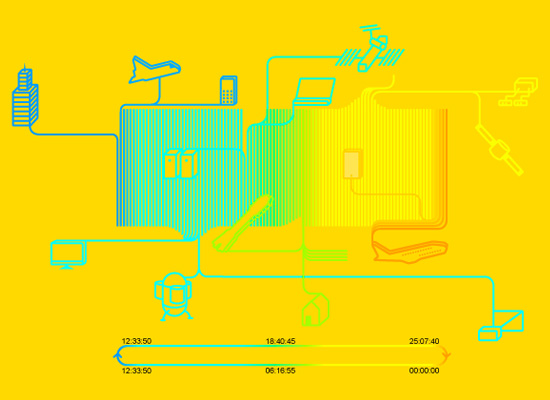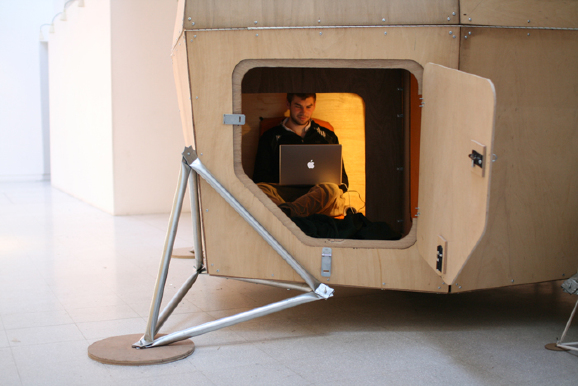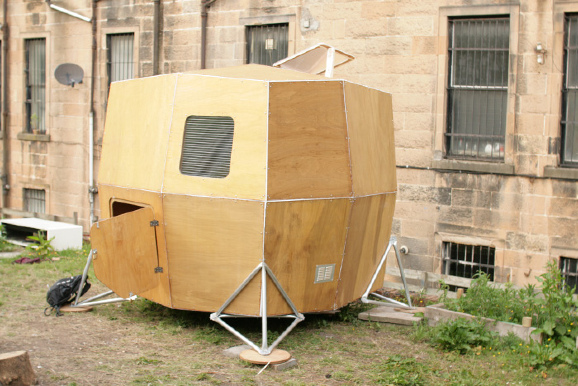Wednesday, July 07. 2010
Via Pruned
-----
by Alexander Trevi

(How's your weather?)
When we set out to upgrade our Blogger Classic Template to Blogger Layouts (or is it Blogger Design?), we planned on streamlining the layout into just one column. But then we accidentally stumbled upon an embeddable personal artificial sun. We were instantly smitten, and knew we had to incorporate it into the new design, single column be damned.
Courtesy of Philippe Rahm and fabric | ch, this sun now flickering above is simply the background color mutating through a 25-hour cycle of bright hues, from warm oranges to fresh greens and cool blues, then back again. These retinal oscillations are an attempt at creating an artificial climate, one which satisfies “the metabolic and physiological requirements of a human being in an environment partially or completely removed from earthly influences: mediated reality, networks and netlag, the disruption of the body clock that comes with air travel, as well as with extra-terrestrial trips and holidays.”
Accessible everywhere and to everybody thanks to the Internet, this artificial climate called i-weather makes it possible to live in a situation completely removed from natural locations by producing an artificial circadian rhythm synchronised to match the inner cycle of the human hormonal and endocrine system. In the absence of the natural terrestrial cycle of day and night, it becomes apparent that this inner cycle in fact lasts around 25 hours, and that body temperature, the alternation between sleep and wakefulness, and the accumulation and secretion of substances such as cortisone and oligopeptides, all depend on it.
Stare for awhile at our twinkling blog or somebody else's and any temporal and spatial displacement you might have acquired from marathon coding or CADing sessions will hopefully be mitigated.
Of course, you could also hack a TV to blast your room with a pastel maelstrom. At airports all over the world, there could also be coin-operated Artificial Weather Climate Rooms for One in which the eternally jet lagged stabilize themselves with a refreshing technicolor shower. Should such enclosures be considered a security threat, perhaps an iPhone reconfigured as a portable weather machine might be enough to spatially and temporally normalize yourself.
In the Archives:
Tropicalia
Personal comment:
We very recently released a new version of I-Weather, a speculative proposition for an artificial climate based on light therapy principles, mainly. It will be used for an installation later this year in San Francisco - San Jose (the 01SJ biennal of curator Steve Dietz).
The climate is open source and free to use. More free applications and pieces of code should appear along the way.
But as I noticed today that Alexander Trevi from Pruned decided to use it on its blog, I take the opportunity to pinpoint it!
-----
by Patrick James

We've done a bit of microhousing (and micro-driving) coverage of late, and here's some more. Inspired by the Urban Nomad movement of the 1960s and 1970s (which focused on diminutive, movable dwellings in cities), a Glasgow School of Art design student named Alec Farmer has built a tiny home in which he'll live for the next year.
Using the instructions written by [Ken] Isaacs in 'How To Build Your Own Living Structures', I have created a replica of this 50 year old design, and plan to live in it, in the centre of Glasgow, Scotland, for one year. In doing so I hope to gain more insight into Isaacs design, and also into the movement as a whole.
I move in at the start of September 2010.
Farmer describes the work of Isaacs as "smaller than architecture but bigger than furniture," and that sounds about right. His Urban Nomad Version 2.0 blog, which chronicles the experience of living in the tiny replica, has the potential to become a great resource for those of us interested in reducing the environmental impacts of our lives—and it already has a bunch of fantastic photographs.
|



